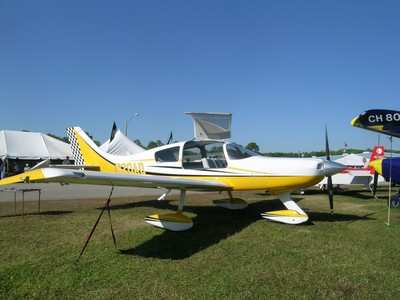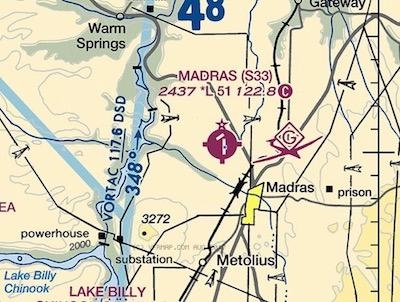Thu, Sep 14, 2017
Had Built Express CT Airplane That Impacted Terrain On Approach To Madras, OR Municipal Airport
The NTSB has released its preliminary report from an accident that fatally injured 58-year-old Rich Wheeler, who was traveling to Madras Municipal Airport in Oregon to view the total solar eclipse last month.

According to the report, the airplane impacted the wall of a canyon while on approach to land at the Madras Municipal Airport (S33) in Madras, Oregon. The pilot/owner was the sole occupant of the airplane. Wheeler was on a cross-country personal flight which originated from San Carlos, California at an unknown time with a final destination of Madras. Visual meteorological conditions prevailed and no flight plan had been filed.
The pilot submitted a reservation request and payment to the Madras airport operations on July 22, 2017 indicating that he intended to arrive on August 19, at 1400 and depart on August 21. The pilot was planning to camp at the airport and participate in the Oregon Solarfest, where activities were being held for the viewing of the solar eclipse.
A Notice to Airmen (NOTAM) was in effect at the time of the accident, which gave instructions to pilots as to the procedures they must follow to land at the Madras airport. A Non−Federal Contract Tower (NFCT) provided air traffic control services at the airport to help facilitate the increased traffic. The NOTAM instructed pilots that all arrivals into Madras must be conducted at the time of their assigned reservation and via the routes depicted in the NOTAM unless otherwise instructed by the controllers. When arriving from the south, the NOTAM stated that the pilot should perform the "Cove Entry," which consisted of reporting over the Cove Palisades State Park (COVE) and fly north to Lake Simtustus Resort (RESORT), then to continue inbound toward the airport (east) and enter a left downwind for runway 34 (south). According to the controller working at the tower at the time of the accident, the pilot checked in at COVE and was instructed to report his position when he was over RESORT. Several
minutes later, after other traffic departed, the controller modified the pilot's instructions and told him to proceed to a 3-mile final to runway 34. After a few minutes, the controller requested that the pilot report his position to which he responded that he was on a 3-mile left base to runway 34. The controller cleared him to land and observed a plume of smoke shortly thereafter.

Witnesses stated that they observed the airplane turn and dive in a nose-low near-vertical descent toward the ground. The accident site was located on the north-facing slope of a canyon comprised of soft dirt and trees. The wreckage was about 1.1 nautical miles from the approach end of runway 34 on a bearing of 190 degrees. The first identified points of contact consisted of freshly severed tree limbs adjacent to the main wreckage. The debris field was primarily contained in the area of the main wreckage on a 60-70 degree slope at an elevation of about 2,350 feet msl. The area of contact was in a slight ravine in the ebb of the canyon wall. The main wreckage had been subjected to severe thermal damage and consisted of the outboard right wing, empennage, engine, and the mostly ashen remains of the fuselage. The cabin was completely consumed by fire. The wreckage was recovered for further examination.
(Image from file. Not accident airplane)
More News
Aero Linx: Space Medicine Association (SMA) The Space Medicine Association of the Aerospace Medical Association is organized exclusively for charitable, educational, and scientific>[...]
Jamming Denotes emissions that do not mimic Global Navigation Satellite System (GNSS) signals (e.g., GPS and WAAS), but rather interfere with the civil receiver's ability to acquir>[...]
Aero Linx: Warbirds of America The EAA Warbirds of America, a division of the Experimental Aircraft Association in Oshkosh, Wisconsin, is a family of owners, pilots and enthusiasts>[...]
"From New York to Paris, this life-size replica of the Webb Telescope inspired communities around the world and, in doing so, invited friends and families to explore the cosmos tog>[...]
Hold-In-Lieu Of Procedure Turn A hold-in-lieu of procedure turn shall be established over a final or intermediate fix when an approach can be made from a properly aligned holding p>[...]
 ANN's Daily Aero-Linx (04.17.24)
ANN's Daily Aero-Linx (04.17.24) ANN's Daily Aero-Term (04.17.24): Jamming
ANN's Daily Aero-Term (04.17.24): Jamming ANN's Daily Aero-Linx (04.18.24)
ANN's Daily Aero-Linx (04.18.24) Aero-News: Quote of the Day (04.18.24)
Aero-News: Quote of the Day (04.18.24) ANN's Daily Aero-Term (04.18.24): Hold-In-Lieu Of Procedure Turn
ANN's Daily Aero-Term (04.18.24): Hold-In-Lieu Of Procedure Turn




